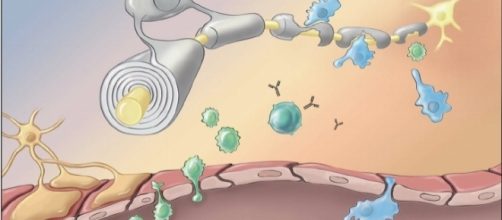T lymphocytes, one of several populations of white blood cells, are able to repair damaged myelin in Multiple Sclerosis. The important discovery was made by neuroscientists at the Queen's University Belfast, in Northern Ireland, and published in Nature Neuroscience.
White blood cells and multiple sclerosis
The visual and cognitive deficits of multiple sclerosis are due to the progressive destruction of myelin, the insulating material that protects and nourishes neurons and makes the communication between them faster and more effective. For reasons still largely unknown, in multiple sclerosis the Immune System attacks and destroys the myelin.
In the long run, this makes the communication between neurons slow and unreliable and, therefore, between the different nervous centers.
However, the immune system appears to play a double role in the case of multiple sclerosis. Specifically, T lymphocytes that circulate in the blood and help to defend the body from potentially harmful external agents, in the case of multiple sclerosis are at the center of an autoimmune process that ends up with the degradation of myelin sheaths. On the other hand, recent evidence suggests that the same T lymphocytes also play a role in myelin repair.
The T-reg lymphocytes promote myelin repair
"T lymphocytes are not a single population" explains Yvonne Dombrowski first author of the study "and we speculated that T-reg lymphocytes, so named because they exert a regulatory action on the immune response, were responsible for the myelin repair process, meaning the reconstruction of the myelin sheath".
To test their hypothesis, neuroscientists at the Queen's University Belfast have studied a group of mice. They found that when mice were deprived of T-reg lymphocytes, the process of myelin repair was inadequate. On the contrary, when researchers reintroduced T-reg lymphocytes in the same mice, they detected the ability of these cells to stimulate the growth of oligodendrocytes, the cells that in the central nervous system produce the myelin sheath.
The study is of crucial importance since it suggests that the myelin can be regenerated. Notably, the study also paves the way to new therapies for multiple sclerosis.

